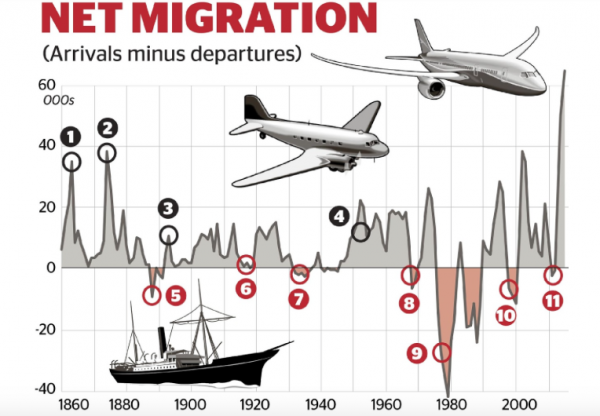
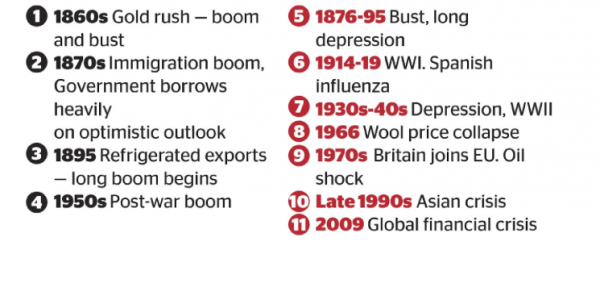
Protecting big business interests
New Zealand immigration policies have always served the needs of big business and reflected the often racist policies and outlook of the ruling class and their governments.
Capitalism is a system of ever-expanding production. Business needs an expanding pool of labour to exploit and it needs a growing market for the goods produced.
The British government established control over New Zealand in a series of wars against the Maori in the 1840s and 1860s. One purpose of these wars was to destroy the “primitive communism” that was being practised by Maori society to “free” the land and labour of Maori for direct exploitation.
Control over the country was given to the local wealthy landowners, bankers and manufacturers. At first, only white males who owned property could vote. In 1867, Maori males could vote for four Maori seats in a parliament of 76 seats. At the time, the Maori population was 50,000 compared to 250,00 Europeans. By 1890, all males could vote and in 1893 women won the right to vote.
In the 1860s, gold was discovered and tens of thousands of people flocked to New Zealand to make their fortune. This included for the first time a significant number of Chinese, but they were denied any rights. In the 1870s, the government encouraged people to migrate to New Zealand from the UK and Ireland in particular. The fares to New Zealand of 100,000 migrants were paid for by the government. Between 1871 and 1881, the population almost doubled from 267,000 to 501,000.
European-only immigration to New Zealand was encouraged for the next 100 years. Until 1974, this included assisted passage for intending British migrants who were automatically granted permanent residence.
A “White NZ” policy
Prior to 1987, New Zealand ran what was effectively a “White New Zealand” immigration policy. Until 1952, Chinese were not allowed to become New Zealand citizens.They were excluded from eligibility for all welfare benefits until 1935 – including benefits for widows, the blind, children or unemployed – even if they were born in New Zealand.
Following World War Two, government officials implemented a policy that restricted the entry of refugees. In a 1948 letter, Prime Minister Fraser said the New Zealand selection team to decide on which refugees to admit would “be confidentially instructed to omit Jewish and Slav types as being incapable of full assimilation.” The head of the selection team explained in 1951 that they had “rejected those whose colouring would create too great a contrast” with white New Zealanders. The same policies applied before the war and only 1100 Jews were accepted into New Zealand in the 1930s. Many Jews were trapped in Europe and exterminated because countries like the USA, Canada, Australia and New Zealand turned them away.
The Government’s Immigration Division summarised its policy in September 1966 as being “dictated by the relative ease with which different groups of people can be assimilated.” Because of that, they favoured people from Western Europe and the United Kingdom. Some restrictions were placed on people from Southern and Eastern Europe. “The peoples of Asia and Africa, being of a culture alien both to that of European and Polynesian New Zealanders, present more difficult problems of assimilation than any others….. These factors have caused us to place even stricter limitations from these countries than upon South Eastern Europeans.”
The only exception to this racist exclusion was for a small window to be opened to some migrants from the Pacific to work in the growing number factories in South Auckland during the 1950s and 1960s.(19)
However, New Zealand’s population continued to increase relatively slowly. The first million was reached in 1908, the second in 1952 and the third 21 years later in 1973. Population growth then slowed again with just over 375,000 added in the 18 years to 1991. In the late 1970s and 1980s, more people left on a permanent or long-term basis than arrived as new immigrants.
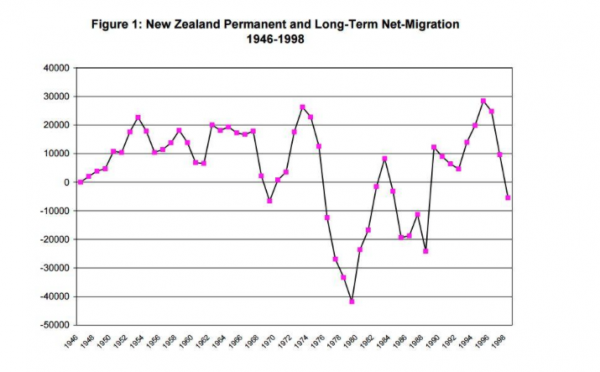
A big factor in migration flows is the relative strength of the Australian economy compared to New Zealand. For most of the period since the 1980s, the resource extraction based Australian economy has grown much more strongly on average. Wages are also significantly higher there as a consequence of this reality, combined with the fact that the bosses in New Zealand were much more successful in driving real wages down, taking a much more aggressive anti-union approach than their counterparts in Australia.
As a consequence, New Zealand has for some three decades been losing 40-50,000 people – around one per cent of its population – to Australia each year. The overall loss of labour resources to Australia needed to be compensated for if the New Zealand economy was to avoid a deep-going crisis. Big business needed labour to exploit at the cheapest price they can get away with paying, as well as a domestic market to sell to. Both goals are undermined by a large permanent migrant flow to Australia.
Big business was dissatisfied and wanted a growing population to exploit as both labour and consumers. This forced a change in government policies towards new migrants. In 1987, the government abolished the official policy of preferring migrants only from “traditional sources” – that is the white countries of Britain and Western Europe. The 1990 National government adopted the more objective “points system” for qualifying for permanent residence. This awarded points for work skill and experience, money, education and language.
Between 1982 and 1987, the number of annual approvals for residence was around 10,000 per year. In 1988, approvals jumped to over 25,000 and remained there until 1994, when another increase to 43,000 occurred. In 1995 the approvals numbered 56,260, and in 1996 42,729 applications were approved.
Asian migration surge
The change in government immigration policy resulted in an initial surge of new migrants from China and other Asian countries and provoked a public debate on immigration. The leader of the newly formed New Zealand First Party, Winston Peters, promoted anti-immigrant rhetoric that gained some popular support. Peters became part of the National-led government after the 1996 election and the brakes came on again for resident permits being issued. Rules were tightened, including a tougher language test. The number of residence approvals declined to 33,683 in the year ended June 1997.
This declining trend continued into 1998, bringing down the net gains in permanent and long-term (PLT) migration, from 24,793 in 1996 to 9,650 in 1997 and a net loss of 5,460 in 1998 (Figures for 1997 and 1998 are for years ending November).
Peters was kicked out of the government in August 1998 and immigration policy was again modified to reverse what had become an immigration outflow in PLT numbers and meet the new and more modest official target of a net annual gain of 10,000 people.
A Labour Party-led government was elected in 1999 and a new period of more liberal policy coupled with stronger economic growth led to a new surge in net migration. Some tightening occurred following the 2002-2003 boom in net PLT numbers. But residence permits issued remained over 50,000 a year by 2005/6.
Net PLT arrivals again dropped sharply after the 2008 world financial crisis as arrival numbers stabilised while there was a surge in departures to Australia.
Following the election of the National government in 2008, the number of permanent residence permits issued annually was tightened again with numbers dropping below 40,000 in 2012/13 before a slight recovery to 43,000 in 2014/15. Permanent resident approvals rebounded in 2015/16 to a near record 52,000.
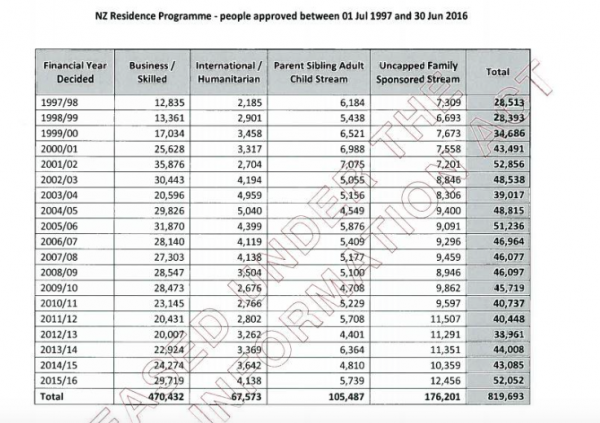
Currently, the government has a permanent resident target of 90-100,000 over a two-year period. This is only a modest expansion from the 40-50,000 aprovals each year for the last 15 years.
National, however, has cranked up the temporary visas with work rights massively to over 250,000 a year by 2014/15.
Fluctuations in permanent and long-term migration numbers
The number of PLT migrants arriving and leaving New Zealand is made up of a number of categories. This includes New Zealand citizens or permanent residents arriving or leaving for an intended 12 months or more, students on visas longer than three months, working holiday visa holders, and those arriving or leaving on a PLT basis who have a temporary work visa.
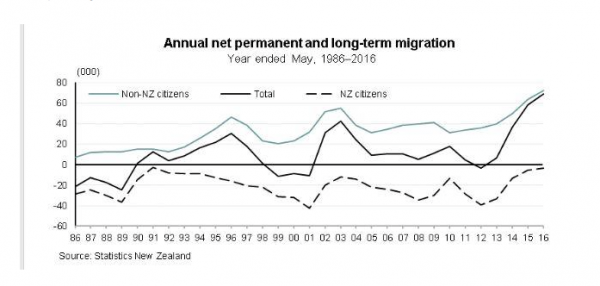
Relative employment conditions here and overseas largely govern the movement of New Zealand citizens and residents, whilst policy changes impact more on temporary work and student visas holder and those being granted permanent residence. New, permanent resident visa holders from overseas usually have a year to move to New Zealand after approval is given.
Juggling all the various elements is a difficult game and it is not obvious that anyone managing New Zealand’s immigration policy has a clear idea what they are doing and why.
The number of actual PLT arrivals fluctuates significantly depending on economic conditions and government policy changes. During the 1990s, arrivals were around 60,000 a year for the decade with a surge to 80,000 in 1996. In the 2000s, the number jumped to almost 100,000 in 2003 then dropped to 80,000 a year until the most recent leap to over 120,000 in 2015.
Net migration peaked for a new record 69,000 in the year to July 2016.
A return to relatively high permanent resident visas being issues, plus the record numbers of temporary student and work visa holders, and a halt to the drain of New Zealand residents to Australia in the last year or so, has seen New Zealand achieve a record population grain in the year to June 2016.
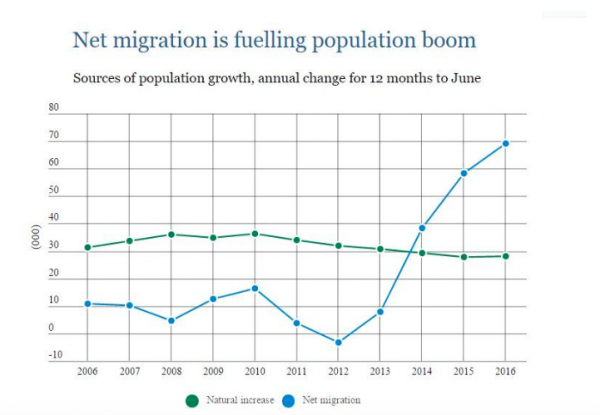
Stuff reported August 12 that “Booming migration means New Zealand’s population has seen the biggest increase of all time. Figures from Statistics New Zealand on Friday showed the population grew by 97,300 in the year to June 30, to 4.69 million. ‘This is the largest annual increase ever,’ Statistics New Zealand said.
“In percentage terms, the 2.1 per cent increase is the largest since 1974.
“Figures provided by Statistics NZ show that the rate at which New Zealand’s natural population has been increasing had been generally declining since 2011, but climbed by 500 in 2016, to an increase of 28,200.
“Net migration meanwhile, has surged. New Zealand saw a net loss from migration in 2012, but migration overtook natural growth in 2014, and is now more than double natural growth.”
Once New Zealand started sourcing new migrants from anywhere in the globe using “objective” criteria that can be adjusted at will, governments have been able to manipulate migrant flows to suit their own agendas more easily. With China and now India becoming a major source of migrants, there is also an almost unlimited potential inflow depending on policies adopted.
NZ population changing
The migration inflows and outflows have transformed New Zealand society. Approximately one in four of its population today of 4.24 million is born outside the country. In the main city Auckland, nearly 40 per cent of its 1.4 million population was born outside New Zealand. One in four Auckland residents are now Asian. There are also a million New Zealand-born people living outside the country.
At the same time as the government has made it easier for a wider range of immigrants with the skills or cash to come here, it has made it harder for anyone without cash, skills or permanent residence to stay. Schools, hospitals and universities now close their doors to those without proper papers and charge increasingly steep fees for those who are here legally but with “temporary” status. Unemployment and other welfare benefits are denied, and even someone with permanent residence is now forced to wait until two years before getting access to welfare. There have been massive increases in fees charged to potential new migrants at all stages of the process. Legal aid has been refused to those appealing against Immigration New Zealand decisions.
As I explained earlier, the current government appears to be opening the tap on migrant inflows even further. What is different this time is that it has massively expanded the issuing of student and temporary work visas. This has created a huge pool of labour desperate to work permanently in New Zealand, but the vast majority of those people are not able to do so. This creates a pool of vulnerable, easily exploited labour – and that is the purpose of the policy.
Using the MBIE data for the 2014/15 year, 170,814 temporary work visas were issued that year as well as 84,856 student visas.
A policy change to allow more Indian students in has seen their number go from almost zero a few years ago to become the second-largest country of origin group with over 20,000 approvals a year – one in four of the total overseas students enrolled.
In the last six years, there have been on average 166,000 temporary work visas issued each year. These consist of people on working holidays, seasonal workers, essential skills workers and migrant family members.
Inland Revenue Department data from 2011, before the more recent in temporary migration surge, shows one in every 20 months worked in the economy is performed by temporary migrants. This is an increase from one in 100 a decade before in 2001. For the hospitality, horticulture and viticulture industries, it is more like one in 10 months worked. “Accommodation” and “Food and Beverage Services” have 14% of all months worked performed by temporary migrant labour.
In 2011 those on temporary visas worked 4.3% of the 23 million months worked. International students worked about 150,000 months a year, essentials skills workers about 230,000 months, working holidays’ visa workers 200,000 months, and seasonal workers 30,000 months. Indian temporary migrants are now the largest group with 180,000 months a year.
IRD records are likely to underestimate actual number worked given many migrants are working “under the table” and not paying tax.
There are over 150,000 migrant workers in New Zealand on temporary work and student visas with work rights at any one time.
Around 30,000 are on working holiday visas and the primary purpose of their visit is meant to be the holiday! The inevitable result is they often work under the table. But at least they can quit their jobs and get new ones if the situation is very bad.
There are also 100,000 here on student visas. Most can work up to 20 hours a week and full time on holidays and about 30 per cent are thought to do so.
Around 30,000 are on essential skills work visas where employment is tied to a particular employer. If these workers find themselves in a role that is exploitative, dangerous or under a violent manager, they have no ability to seek other employment without losing their visa and being deported.
Another 30,000 have family work visas as partners of someone on a student or skilled work visa. Study to work visas account for 15,000 and 10,000 mainly Pacific Island workers are in horticulture and viticulture.
Only about 20,000 a year transition to residence from the skilled work scheme.

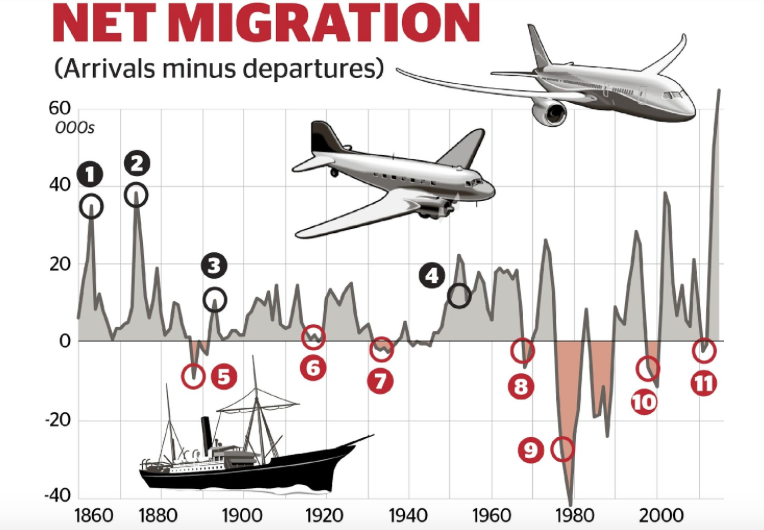




Who asks the public – Maori, Pakeha or others.
No one as key will force genocide upon us all, as we cannot be his slaves.
Quoted from above:
“Juggling all the various elements is a difficult game and it is not obvious that anyone managing New Zealand’s immigration policy has a clear idea what they are doing and why.
The number of actual PLT arrivals fluctuates significantly depending on economic conditions and government policy changes. During the 1990s, arrivals were around 60,000 a year for the decade with a surge to 80,000 in 1996. In the 2000s, the number jumped to almost 100,000 in 2003 then dropped to 80,000 a year until the most recent leap to over 120,000 in 2015.”
“Stuff reported August 12 that “Booming migration means New Zealand’s population has seen the biggest increase of all time. Figures from Statistics New Zealand on Friday showed the population grew by 97,300 in the year to June 30, to 4.69 million. ‘This is the largest annual increase ever,’ Statistics New Zealand said.
“In percentage terms, the 2.1 per cent increase is the largest since 1974.””
“Once New Zealand started sourcing new migrants from anywhere in the globe using “objective” criteria that can be adjusted at will, governments have been able to manipulate migrant flows to suit their own agendas more easily. With China and now India becoming a major source of migrants, there is also an almost unlimited potential inflow depending on policies adopted.”
My view on all this:
This is another very good post by Mike Treen. He brings together a lot of data and presents a rather balanced view and interpretation of them. What we can see is how neoliberal government, and with that I include Labour, have used immigration to boost economic growth. We know that per capita GDP is different to the overall GDP rate we so often get presented. I assert that we have not benefited as much from immigration as some politicians have been trying to tell us. It is per capita GDP growth and better productivity that can improve our living standards, but there are of course also other factors to consider, when we look at the quality of lives.
And I take note of this also:
“NZ population changing
The migration inflows and outflows have transformed New Zealand society. Approximately one in four of its population today of 4.24 million is born outside the country. In the main city Auckland, nearly 40 per cent of its 1.4 million population was born outside New Zealand. One in four Auckland residents are now Asian. There are also a million New Zealand-born people living outside the country. ”
When we compare our immigration over recent decades and especially the present with the rate of immigration of countries like Canada, the US and even the UK, we have the highest rate of immigrants per capita and over recent years have had the highest rate of immigration measured in percentage growth, particularly when compared to the existing population.
In my view this is not sustainable, as our housing affordability crisis and the over crowded housing in parts of our larger cities, especially in South and also West Auckland show. People commuting in cars and even using public transport give us ample anecdotal evidence of our transport systems not coping well. Teachers, nurses and police officers think more than twice now to work in Auckland, as it has become so unaffordable for most, looking at housing costs and also the stress of commuting.
And re the massive increase in temporary work visas issues, we can see this government is hell bent on keeping people in competition with migrant workers, who will not complain, will not dare ask for too much and who will put up with almost anything, as many will also hope to get PR.
Hence wages and salaries stay low, but with housing being in crisis now, the pressure has built so that people are now increasingly asking what is the benefit of immigration.
https://www.tvnz.co.nz/one-news/new-zealand/record-migration-levels-soaring-house-prices-two-big-issues-dominating-political-agenda
Only the so relaxed mentality of many NZers still leaves many putting up with the situation, thinking they can live with it.
The fact that so many New Zealanders did leave over past decades is also a worry, as they have mostly been qualified people, who sought better opportunities, working conditions and pay overseas.
We have developed a somewhat low wage economy when compared with the countries we tend to compare ourselves with, and the leaving of many born and bred Kiwis, and in some cases also established immigrants leaving again, has enabled governments to keep wages down.
With probably between half and a million of New Zealand passport holders and residency holders living in other places, what happens if they should also return one day?
New migrants have filled the gap and that shows in our health sector work force, where about half of all staff seem to have a migrant background. In the age care sector it is even worse, as few NZers want to work in that low pay environment.
Gradually farm work is becoming more low pay, that is despite of comments by farming business owners and horticulturalists, who go on about how “well paid” their workers are. Looking at hours worked and pay received, most agricultural workers do not really earn all that much per hour.
Our supermarkets are full of migrant workers, certainly here in Auckland, and now we have the construction industry hire high numbers of migrant workers also.
Low wages are here to stay if this is allowed to continue, NZers still have the right to vote and change some of this, but as we have too few INFORMED voters, that is due to biased and also poor reporting by the MSM, we can only hope that enough are informed enough through their daily experiences to vote as they perhaps should next year.
Like the post also Mike well researched.
Have a look at this and know what to expect:
http://www.zerohedge.com/news/2016-09-12/majority-worlds-population-lives-circle
The economist Michael Reddell has some extremely interesting blog posts on immigration. He pretty much says that it hasn’t done the country much good, and he can’t find any evidence that it’s done any other similar countries much good.
The only other country with more immigration than NZ is Israel, and their productivity is worse than ours.
https://croakingcassandra.com/category/immigration/
My take on how things are with immigration at the moment is that the Nats believe ideologically that “Immigration Is Good” like they believe in “The Market”. Unfortunately this is like entrusting our economy to Santa Claus and the Tooth Fairy.
[…] record population growth in the year to June was enabled by the government approving a near record number of new residents, […]
Some interesting figures there, which I didn’t have. I see Residence figures [ long term ] show just over half the residence approvals are associated with skills /business.
You have net migration at 70,000 for 2016. Not sure of your beginning and end dates. The common figure we use for 2015 is about 65,000 think. Estimation of Immigrants to Auckland last year is 40,000 with 7000 houses built.
The political beneficiary of this shambles as you will know, NZ First.
Good articles.
Comments are closed.